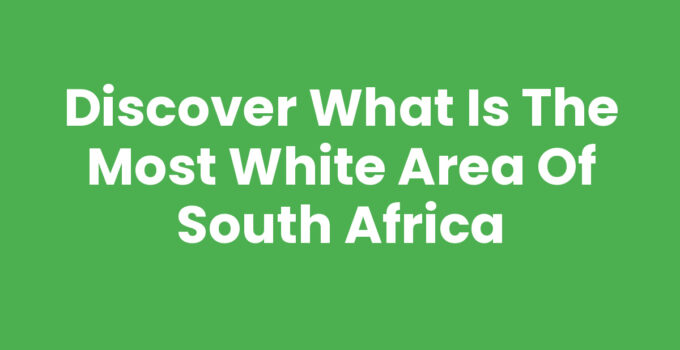South Africa is a nation of diverse cultures, landscapes, and populations. Understanding its demographic complexities is crucial in appreciating its rich history and societal structures. One question that arises frequently is, “What is the most white area of South Africa?” This inquiry not only probes geographical boundaries but also touches on historical contexts, socio-political dynamics, and cultural flora.
What is the Most White Area of South Africa?
The area often cited as the most predominately white area in South Africa is the Western Cape Province, particularly around Cape Town and its neighboring regions, like Stellenbosch and Franschhoek. This region boasts a significant white population, primarily of Afrikaner and English descent.
Historically, the Western Cape has been seen as a bastion of white South Africans. During the apartheid era, areas were segregated based on race, and the Western Cape was one of the provinces where government policies heavily favored white inhabitants. Today, the demographics have shifted somewhat due to urban migration and social reforms, but the historical roots still show strong correlation with demographic distributions.
Key towns in this area include:
- Cape Town: Known for its breathtaking landscapes and vibrant multicultural ethos, Cape Town remains a focal point for white residents.
- Stellenbosch: A university town famous for vineyards and agriculture, supported by a rich community and strong academic demographics, it has a large white population.
- Franschhoek: Previously a French Huguenot settlement, this town still has deep historical ties and a considerable number of white residents.
Understanding these areas requires acknowledging both their white majority and the vibrant multicultural community surrounding them. Today, the Western Cape stands out for its scenic beauty, rich heritage, and the hustle of urban life.
Recommended Reading: Explore Mediclinic Bloemfontein: Exceptional Healthcare Services
The Historical Context of White Communities in South Africa
The historical underpinnings of white communities in South Africa can be traced back to European colonization in the 17th century, where Dutch settlers formed the initial white demographic. The legacy of colonial rule paved the way for segregation and the establishment of apartheid, which strictly divided citizens based on race, further entrenching white communities in certain regions.
Throughout the years, these demographics created lasting imprints on economic opportunities, land ownership, and political representation. The Western Cape, for instance, promised prosperous farming lands, which attracted settlers, making it a base for agricultural and economic development, significantly skewed toward white populations.
Despite the fall of apartheid and the progressive reforms in governance that allowed for a more mixed society, the societal scars and economic divides persist, leading to lingering concentrations of white communities, particularly in the Western Cape.
Read Also: Explore Abelia Avenue, Bloemfontein: Your Ultimate Guide
Socio-Political Dynamics and Current Implications
In modern-day South Africa, the socio-political context has evolved, with significant ongoing discussions about race, equality, and economic disparity. The Western Cape, with its large white population, often finds itself at the center of debates regarding land reform and economic redistribution.
White communities in this region, while a minority overall, often have substantial socio-economic advantages. Issues related to land ownership, business opportunities, and access to quality education continue to be hotly contested topics. Protests and discussions surrounding transformation policies have arisen, showcasing the complexities of moving toward an equitable society.
Furthermore, the Western Cape also faces challenges of racial tensions and social integration. The blend of cultures brings opportunities for richness in diversity but also exposes socio-economic divides that need attention to foster a more cohesive society.
Read Also: Discover the Beauty of Naval Hill, Bloemfontein: A Must-Visit!
Conclusion: The Future Landscape of South Africa
In conclusion, when asking, “What is the most white area of South Africa?” the answer remains a nuanced discussion reflective of historical patterns and ongoing societal transformations. The Western Cape exemplifies the complexity of this query with its rich tapestry of cultural identity and the socio-political implications of race in South Africa.
As South Africa progresses, the focus on integration, equality, and the acknowledgment of historical contexts will shape the country’s future landscape. Understanding these elements is essential for fostering a society where diversity is embraced, and equity is pursued.
Read Also: Discover the Best Squash Courts in Bloemfontein Today!
Frequently Asked Questions
What factors define the most white area in South Africa?
Factors include historical settlement patterns, current demographics, and socio-economic conditions shaping residential areas.
How has the white population in South Africa changed over the years?
Post-apartheid, there has been a demographic shift due to urban migration, economic opportunities, and policy changes.
What challenges do white communities face in South Africa today?
Challenges include addressing inequality, socio-economic disparities, and integrating racial diversity within communities.



